Input interpretation

propane
Chemical names and formulas
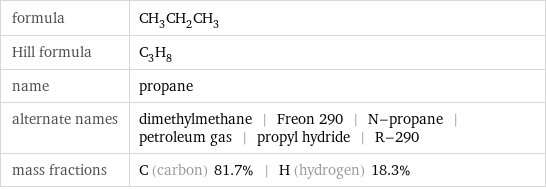
formula | CH_3CH_2CH_3 Hill formula | C_3H_8 name | propane alternate names | dimethylmethane | Freon 290 | N-propane | petroleum gas | propyl hydride | R-290 mass fractions | C (carbon) 81.7% | H (hydrogen) 18.3%
Lewis structure
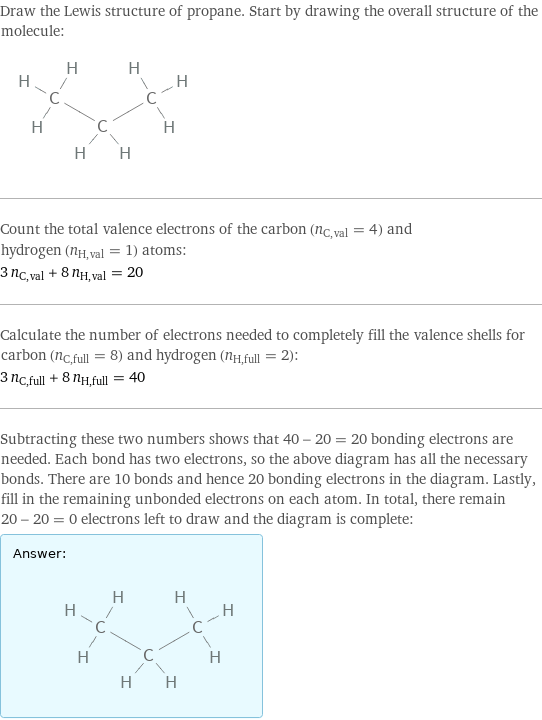
Draw the Lewis structure of propane. Start by drawing the overall structure of the molecule: Count the total valence electrons of the carbon (n_C, val = 4) and hydrogen (n_H, val = 1) atoms: 3 n_C, val + 8 n_H, val = 20 Calculate the number of electrons needed to completely fill the valence shells for carbon (n_C, full = 8) and hydrogen (n_H, full = 2): 3 n_C, full + 8 n_H, full = 40 Subtracting these two numbers shows that 40 - 20 = 20 bonding electrons are needed. Each bond has two electrons, so the above diagram has all the necessary bonds. There are 10 bonds and hence 20 bonding electrons in the diagram. Lastly, fill in the remaining unbonded electrons on each atom. In total, there remain 20 - 20 = 0 electrons left to draw and the diagram is complete: Answer: | |
3D structure

3D structure
Basic properties
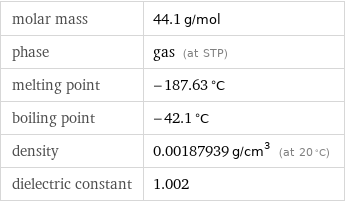
molar mass | 44.1 g/mol phase | gas (at STP) melting point | -187.63 °C boiling point | -42.1 °C density | 0.00187939 g/cm^3 (at 20 °C) dielectric constant | 1.002
Gas properties (at STP)
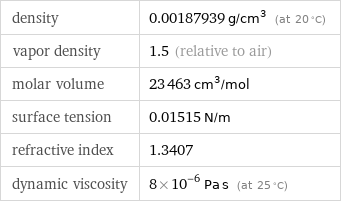
density | 0.00187939 g/cm^3 (at 20 °C) vapor density | 1.5 (relative to air) molar volume | 23463 cm^3/mol surface tension | 0.01515 N/m refractive index | 1.3407 dynamic viscosity | 8×10^-6 Pa s (at 25 °C)
Units

Thermodynamic properties
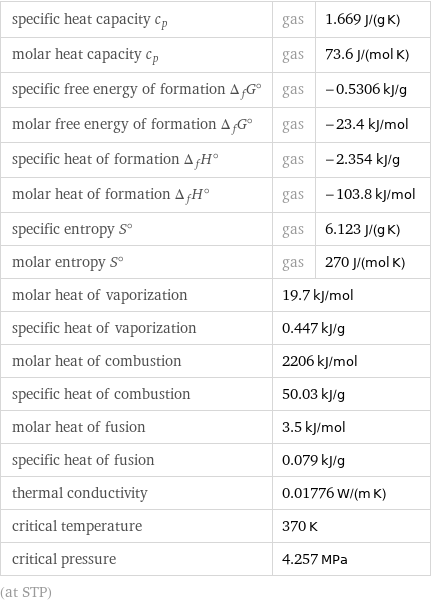
specific heat capacity c_p | gas | 1.669 J/(g K) molar heat capacity c_p | gas | 73.6 J/(mol K) specific free energy of formation Δ_fG° | gas | -0.5306 kJ/g molar free energy of formation Δ_fG° | gas | -23.4 kJ/mol specific heat of formation Δ_fH° | gas | -2.354 kJ/g molar heat of formation Δ_fH° | gas | -103.8 kJ/mol specific entropy S° | gas | 6.123 J/(g K) molar entropy S° | gas | 270 J/(mol K) molar heat of vaporization | 19.7 kJ/mol | specific heat of vaporization | 0.447 kJ/g | molar heat of combustion | 2206 kJ/mol | specific heat of combustion | 50.03 kJ/g | molar heat of fusion | 3.5 kJ/mol | specific heat of fusion | 0.079 kJ/g | thermal conductivity | 0.01776 W/(m K) | critical temperature | 370 K | critical pressure | 4.257 MPa | (at STP)
Phase diagram

Phase diagram
Units

Chemical identifiers
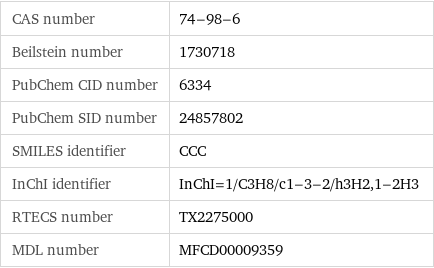
CAS number | 74-98-6 Beilstein number | 1730718 PubChem CID number | 6334 PubChem SID number | 24857802 SMILES identifier | CCC InChI identifier | InChI=1/C3H8/c1-3-2/h3H2, 1-2H3 RTECS number | TX2275000 MDL number | MFCD00009359
NFPA label

NFPA label
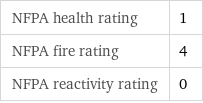
NFPA health rating | 1 NFPA fire rating | 4 NFPA reactivity rating | 0
Safety properties
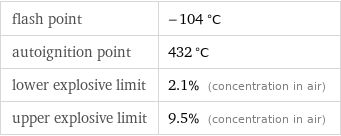
flash point | -104 °C autoignition point | 432 °C lower explosive limit | 2.1% (concentration in air) upper explosive limit | 9.5% (concentration in air)

DOT hazard class | 2.1 DOT numbers | 1978